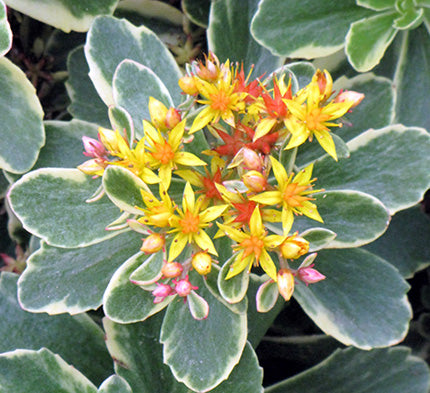
Drought Tolerant List
Nancy DuBruleShare
Drought Tolerant Plants



Plants on this list have survived the two month heat wave and severe drought of the summer of 2022. In most cases, they did so without any supplemental watering. In a few cases, one or two deep soakings made them revive quickly. Some of the reasons these plants are drought resistant are that they have swollen storage roots such as tubers or corms or that they have an extremely deep and large root systems.
- Plants (especially shrubs) that have been planted in the past 1-3 years should be monitored during a drought. It is not until they are well established that drought tolerance kicks in. Check the plants often. If they are wilted AFTER the sun sets, deep soak them.
- Heat zones are a factor. Plants transpire water much faster in a south or west facing exposure, if surrounded by pavement or stones or any material that holds heat such as foundations, driveways, patios.
- If plants are installed into the root system of large, established trees, the trees will take the water first. Even notoriously drought tolerant plants will have to be watered for the first season until their root system is established.
- Soil type matters. Sandy soils drain away any water quickly. Clay soils hold water, but, once completely dry, turn as hard as a rock.
- Some plants live through a drought to grow and bloom another year, but look really unsightly. They are not included on this list. One example is Hemerocallis (daylilies). They have swollen storage roots but, in a drought, the leaves turn yellow and brown. If you cut off all the bad leaves, they will grow new ones when it rains again. Another example are New England asters (Aster novae-angliae). They survive and eventually flower but the leaves turn brown and yellow.
- Some plants are quite drought tolerant but need to be watered when they are in flower in order to set fruit. Callicarpa (beautyberry) is an example and should be deep soaked at least once or twice in late July and August when it is in bloom.
- If a plant is described as “moisture tolerant”, that means it can grow in water-saturated soils and still survive. BUT, some moisture tolerant plants can also survive a long dry spell. Examples are Vernonia (ironweeds) and Iris ensata (Japanese irises).
We welcome your comments on this list as we work together to create more resilient gardens.
Perennials
Achillea-yarrow
Aconitum- monkshood
Agastache- licorice mint
Allium- ‘Millenium’, ‘All Summer Beauty’, thunbergii ‘Ozowa’
Amsonia-blue star
Anaphalis-pearly everlasting
Anemone nemerosa- wood anemone
Anthemis tinctoria- perennial Marguerite
Arabis- rock cress
Armeria-sea thrift
Asclepia tuberosa-butterfly weed and Asclepias verticillata-whorled milkweed
Aster ericioides, laevis, oblongifolia, umbellatus- asters
Aurinia-basket of gold
Baptisia-false indigo
Belamcanda-blackberry lily
Boltonia asteroides
Calamintha-calamint
Callihroe involucrate-poppy mallow
Campanula poscharskyana- bell flower
Caryopteris divaricata ‘Snow Fairy’- herbaceous blue mist shrub
Cerastium-snow in summer
Coreopsis-tickseed
Corydalis- rock harlequin
Crambe maritima-sea kale
Dalea purpurea-purple prairie clover
Delosperma-ice plant
Dendranthema-perennial chrysanthemum
Dianthus-pinks
Dicentra- bleeding heart
Digitalis-foxglove
Disporum flavens-yellow fairy bells
Echinacea-coneflower
Epimedium-barrenwort
Erigeron- including Erigeron pulchellus ‘Lynnhaven Carpet’- fleabane
Eryngium-sea holly, rattlesnakemaster
Euphorbia-spurge
Gaillardia-blanket flower
Gaultheria procumbens-wintergreen
Gaura
Geranium- especially G. macrorrhizum
Gypsophila-baby’s breath
Helianthemum-sun rose
Helianthus tuberosus- Jerusalem artichoke (other perennial sunflowers may survive a drought but look unsightly if not watered at least once or twice)
Heliopsis-false sunflower
Helleborus (may need one or two deep soakings but will revive)
Heuchera- coral bells, alum root
Hosta
Iberis-candytuft
Inusla helenium- elcampagne
Iris germanica, Iris pallida ‘Variegata’, Iris sibirica, Iris pumila
Kalimeris integrifolia-Japanese aster
Kniphofia-red hot poker
Lathyrus vernus-spring vetchling
Leucanthemum ‘Becky’-Shasta daisy
Liatris-gayfeather
Lychnis coronaria-rose campion and L. chalcedonica-Maltese cross
Maclaeya cordata-plume poppy
Mertensia virginica- Virginia bluebells (summer dormant)
Mitchella repens- partridge berry
Nepeta-catmint
Nipponanthemum nipponicum-Montauk daisy
Oenothera- evening primrose
Opuntia-prickly pear
Pachysandra procumbens-native deciduous pachysandra
Paeonia-peony (both herbaceous and tree)
Papaver orientalis- Oriental poppy (summer dormant)
Penstemon-beard tongue
Parthenium integrifolium-wild quinine
Perovskia-Russian sage
Persicaria polymorpha-Giant fleeceflower
Phlox subulata-creeping phlox, May pinks
Physostegia virginica-obedient plant
Platycodon-balloon flower
Podophyllum peltatum-mayapple
Polygonatum-Solomon’s seal
Potentilla-herbaceous cinquefoils such as P. tridentata, P. x tonguei
Prunella vulgaris-heal all
Rudbeckia-black eyed Susan
Salvia-ornamental sage
Sanguinaria canadensis-bloodroot (summer dormant)
Sedum- stonecrop
Sempervivum- hens and chicks
Solidago-goldenrod
Stachys byzantina -lamb’s ears
Stokesia-Stoke’s aster
Symphytum-ornamental comfrey such as S. grandiflorum, S. ‘Hidecote Blue’
Tanacetum parthenium-feverfew
Verbascum-mullein
Vernonia-ironweed
Veronica peduncularis ‘Georgia Blue’
Waldsteinea-barren strawberry
Yucca filamentosa
Zizia- Golden Alexanders (may need one good soaking, will revive)
Herbs
Artemesia
Hyssopus-hyssop
Lavandula-lavender
Mentha-mints
Origanum- oreganos both culinary and ornamental
Pycnanthemums- Mountain mints
Ruta gravaeolens- rue
Salvia-culinary sage
Santolina
Symphytum-comfrey
Tanacetum- tansy, feverfew
Teucrium-germander
Thymus-thyme
Shrubs
Most evergreen shrubs are quite drought tolerant as they have a waxy coating that helps them retain water. Broadleaf evergreens have more leaf surface to transpire water than needle evergreens.
Abelia grandiflora-glossy abelia
Abeliophyllum distichum- white forsythia
Amorpha canescens-lead plant
Arctostophyllos uva-ursi- bearberry
Azalea mucronulatum- Korean azalea
Aesculus parviflora-bottlebrush buckeye
Baccharis halimifolia-salt bush
Buddleia-butterfly bush
Calluna-heather
Chaenomeles- quince
Comptonia peregrina-sweet fern
Calycanthus -Carolina allspice
Caryopteris-blue mist shrub
Cotinus-smokebush
Cytisus-Scotch broom
Daphne
Erica-spring heath
Hibiscus syriacus- Rose of Sharon
Hypericum-St. Johnswort
Indigofera-indigo bush
Kolkwitzia amabalis- beauty bush
Lagerstroemia- crape myrtle
Leptodermis oblonga
Lespedeza- bush clover
Lonicera fragrantissima-winter honeysuckle
Myrica pensylvanica- bayberry
Rhus-sumac Rhus aromatica ‘Gro-Low’, Rhus copallinum, Rhus glabra, Rhus typhina ‘Tiger Eyes’
Spirea-both spring and summer blooming type
Syringa- lilac
Vitex-chaste berry
Xanthorhiza simplicissima-yellowroot
Ornamental Grasses
Andropogon
Bouteloua gracilis ‘Blonde Ambition’-blue gramma grass
Calamagrostis-feather reed grass
Carex ‘Ice Dance’
Eragrostis-love grass
Festuca glauca-fescue
Helichtotrichon-blue oat grass
Liriope-lilyturf
Molinia-moor grass
Muhlenbergia-muhly grass
Panicum-switchgrass
Schizachyrium-little bluestem
Sorghastrum nutans- Indian grass
Sporobolis heterolepsis-prairie dropseed
